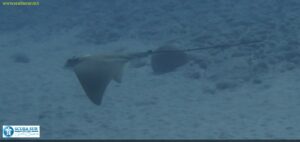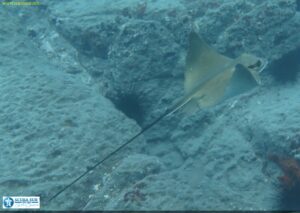Shy but gracious, meet the common eagle ray
The gracious appearance of the common eagle ray always has an amazing effect on divers. Slowly appearing out of the blue, elegantly gliding through the water and disappearing in the open ocean, it always leaves you with a humble feeling.

If you catch one enjoying its meal, it will hurry to swim away, as besides gracious, they are very shy.
How to recognize a common eagle ray?
The common eagle ray is a very majestic swimmer that can reach up to 180cm in length. Its body is diamond shaped and is less than half of its total length. It is easy to recognize with its round snout that resembles the one of a fox and a long thin tail.
The dorsal surface is brown or black while the ventral surface is white.
Scuba Diving
The Common Eagle ray lives in the eastern Atlantic Ocean in depths ranging between 0 and 500m, but is most often found above the 50m depth.

When you spot it, enjoy is. As they are very shy, they will swim off as fast as possible when detecting divers in the water.
Do not mistake them with the Bull Ray, similarly shaped but with a bigger snout and a striped back. The Bull ray is not shy at all and will come closer to investigate who you are.
The common eagle ray diet
You will find the Common Stingray excavating the seabed in order to find crustaceans. Occasionally it will also feed on worms and small fishes.
Some Science
| Kingdom | Animalia |
| Phylum | Chordata |
| Class | Chondrichthyes |
| Order | Myliobatiformes |
| Family | Myliobatidae |
| Genus | Myliobatis |
| Species | Myliobatis aquila |
More Information
We get many questions about what there is to see when you go diving in the south of Gran Canaria. We want to respond to this by creating a number of articles where each highlights a specific species we regularly encounter when diving in the Atlantic. The complete series gives you a good idea of what to find when scuba diving in the blue waters of the south of Gran Canaria. Let’s be clear we are not marine biologists; just a dive centre trying to provide valuable information to our customers.
For the full details of the species we would like to refer to www.Wikipedia.com. Here you’ll find more detail than we go into.


